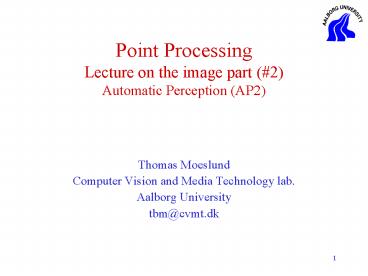Point Processing Lecture on the image part - PowerPoint PPT Presentation
1 / 19
Title:
Point Processing Lecture on the image part
Description:
This is called histogram stretching. 13. Histogram stretching. Algorithm: Find maximum: ... Exercises. Questions to the lecture? ... – PowerPoint PPT presentation
Number of Views:42
Avg rating:3.0/5.0
Title: Point Processing Lecture on the image part
1
Point Processing Lecture on the image part
(2)Automatic Perception (AP2)
- Thomas Moeslund
- Computer Vision and Media Technology lab.
- Aalborg University
- tbm_at_cvmt.dk
2
Topics
- What is point processing?
- Grey level mapping
- Histograms
- Segmentation using thresholding
3
What is point processing?
- Grey level enhancement
- Process one pixel at a time independent of all
other pixels - For example used to correct Brightness and
Contrast (remote control)
Too low contrast
Too high contrast
Too high brightness
Too low brightness
Correct
4
Brightness
- The brightness is the intensity
- Change brightness
- To each pixel is added the value b
- f(x,y) is the input image
- g(x,y) is the (enhanced) output image
- If bgt0 gt brighter image
- If blt0 gt less bright image
g(x,y) f(x,y) b
5
Contrast
- The contrast describes the level of details we
can see - Change contrast
- Each pixel is multiplied by a
- f(x,y) is the input image
- g(x,y) is the (enhanced) output image
- If agt1 gt more contrast
- If alt1 gt less contrast
g(x,y) a f(x,y)
6
Combining brightness and contrast
g(x,y) a f(x,y) b
- Both
- A straight line
- Greylevel mapping
- X-Axis Input Value
- Y-Axis Output Value
- This plot Identity
- Output equals Input
- Apply to each pixel!
- To save time the greylevel
- mapping can be written as a
- Lookup-Table
Output image g(x,y)
Input image f(x,y)
(Show bridge)
7
Histogram
8
How to set the greylevel mapping
k
- Histogram processing a powerfull tool!
9
Histogram Types
Dark Image
Bright Image
Low Contrast
High Contrast
- How can a histogram help? (show PET_scan
TEM_filter)
10
Histogram processing
- Different types of mapping
- Piecewise linear
11
Histogram processing
- Non-linear, e.g., Logarithmic
- Arbitrary
12
Improving contrast
- Humans cannot tell the difference between
greylevel values too close to each other - So spread out the greylevel values
- This is called histogram stretching
13
Histogram stretching
- Algorithm
- Find maximum
- Find minimum
- Shift values so that minimum is 0
- Scale values so that maximum is 255 and write
into output image g(x,y)
max0 //Check each pixel if f(x,y)gtmax maxf(x
,y)
//For each pixel g(x,y)f(x,y)-min
c255/(max-min) //For each pixel g(x,y)round(g(
x,y)c)
14
Histogram Equalization
15
Something really different
16
Segmentation
- Until now Image processing (manipulation)
- Image analysis segmentation
- The task
- Information versus noise
- Foreground (object) versus background
17
Segmentation
- Use greylevel mapping and the histogram
- When two peaks (modes) of a histogram correspond
to object and noise (Show AuPbSn40, bridge) - Find a THRESHOLD value, T, that separates the two
peaks. This process is called THRESHOLDING - Algorithm
- If f(x,y) gt T then g(x,y) 1, else g(x,y) 0
- If f(x,y) lt T then g(x,y) 1, else g(x,y) 0
- Result a binary image where
- object pixels 1 and noise 0
18
What to remember
- Point processing
- Brightness and contrast
- Greylevel mapping
- Histogram
- Thresholding (segmentation)
19
Exercises
- Questions to the lecture?
- What was good about the lecture and what could
have been better? - Discuss the PE-questions
- Download ImageJ http//rsb.info.nih.gov/ij/
- Use ImageJ to play around with greylevel mapping,
histograms and thresholding. Make sure you
understand these concepts! - How will the algorithm look like if two threshold
values are used instead of just one? - Is it wise to have a binary image consisting of
0s and 1s? - Finish the exercises from last time

